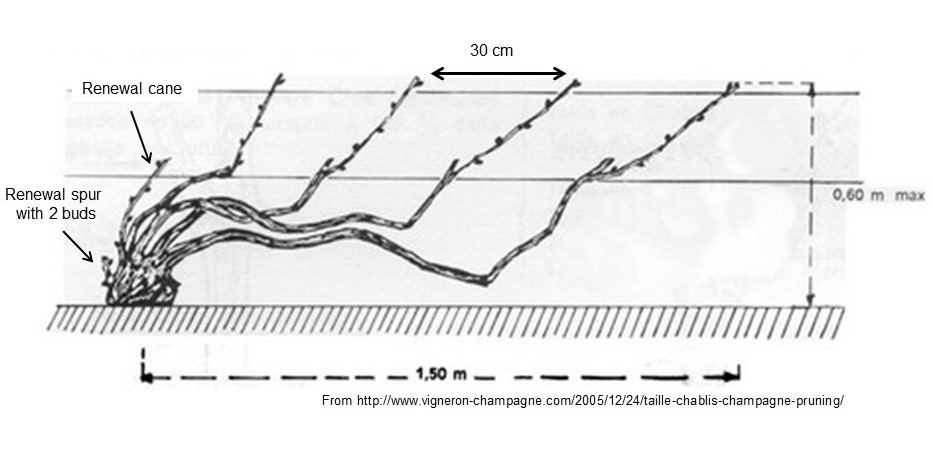Taille Chablis
This is the traditional pruning system for Chardonnay in Champagne.
Understandably, some confusion exists about this form of vine training and pruning. After some detailed personal communications with Dr Alain Deloire, Professor of viticulture at Montpellier SupAgro, in the south of France, here is the definitive situation: taille Chablis is a vertically-shoot positioned (VSP) training/trellis system in which the vine is cordon/arm*-trained and cane-pruned.
In fact, it is a multiple, flexible-armed system, with, typically three-to five permanent arms being grown over a period of about ten years. At its furthest point from the trunk, each arm has a cane which is pruned to a maximum of five buds.
The arms, and therefore the canes, are spaced roughly equally along about 1.5m of the vine row. See figure 1.

Figure 1: Example of Chablis pruning system, with 5 arms and 5 canes bearing 5 buds each. The distance between the canes is 30 cm. The distance between vines is 1.5 m. The height of the second wire is 60 cm from the soil.
From vine planting, the arms are grown over a number of years. For example, after three years of growing a single arm, in the fourth year, a second arm might be started with a retained cane. In the fifth year, a third arm is laid down. And possibly, in the sixth and seventh years, fourth and fifth arms are laid down.
Building up this large amount of permanent structure over a number of years allows the vine to focus as much as possible on grape production (within climatic and legal constraints). To establish all the arms at once would likely keep yields low during the years while this was happening.
After about 10 years, this complex system occupies all of its allotted space. And so, with taille Chablis, the ‘permanent’ arms become renewed on a rolling basis. When the oldest arm reaches the allotted space of its neighbouring vine, the arm is cut off.
For this reason, as with other cane-pruned systems, there is, additionally, a 2-bud spur, ready to become a new cane next year (and in this vine training system, a permanent arm … for a few years).
This rolling renewal of semi-permanent arms allows a good volume of permanent wood to be built up, and prevents each vine from encroaching on the photosynthetic space of its neighbours.
It seems complicated, why do it?
- With plenty of permanent wood, the vine has a buffer of stored carbohydrates and nitrogen in reserve in case of climatically stressful times.
- The system allows a higher yield to be achieved in the cool climate of Champagne, for Chardonnay, which is not a hugely productive cultivar in cool climates.
- For the moment, it is still part of the appellation regulations. The CIVC (Comité Champagne) is trialling, with qualitative success, other training systems, such as a Lyre (cordon with spur-pruning), and an alternative low-density VSP system (cordon with cane-pruning).
- Both Pinot Noir and Meunier are more productive, so cordon-trained, spur-pruned systems (in Champagne called cordon de Royat), or head-trained, cane-pruned systems (single or double Guyot) can be used.
- The canopy training system for all three cultivars is VSP.
* This is an important asterisk. In this training system, the permanent ‘cordon’ does not directly bear the winter buds (2-bud spurs regularly spaced along its length). For this reason, in France, where the system originated, this permanent part of the vine was given a different name – charpente – to make this distinction. Charpente is translated into arm. Arm is the more precise description and will be used in the rest of the piece.
References:
French references kindly provided by Prof. Deloire for academic rigour.
- Carbonneau A., Deloire A., Garrier G. (2001). Quelques éléments historiques de l’évolution des architectures de vigne (première partie). Progr. Agric. Vitic., 118 (7), 155-161.
- Carbonneau A., Cargnello G. (2003). Architectures de la vigne et systèmes de conduite. Dunod, Paris, 188p.
- Carbonneau A., Deloire A., Jaillard B. (2007). La vigne: Physiologie, terroir, culture. In Ecophysiologie. Dunod, Paris, pp 67-105.
- Deloire, A. (2010). History and evolution of vine architecture: diversity of training systems in 19th century in France. Wineland, January. Retrieved from https://www.wineland.co.za/history-and-evolution-of-vine-architecture-diversity-of-training-systems-in-19th-century-france/
Simultanesouly published at: www.grapevine-paradise.com (under ‘teaching’ tab)
Comments
2 Responses to “Taille Chablis”




December 15, 2019 at 11:20 pm
I am your student at the WSET Diploma. Thanks for clarifying my query.
December 16, 2019 at 12:26 pm
You are very welcome. Explaining taille Chablis has been on my radar to explain for some time, so thank you for the ‘nudge’!